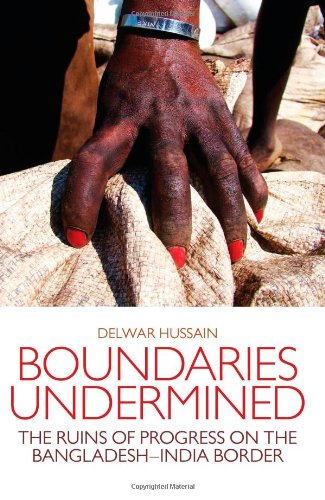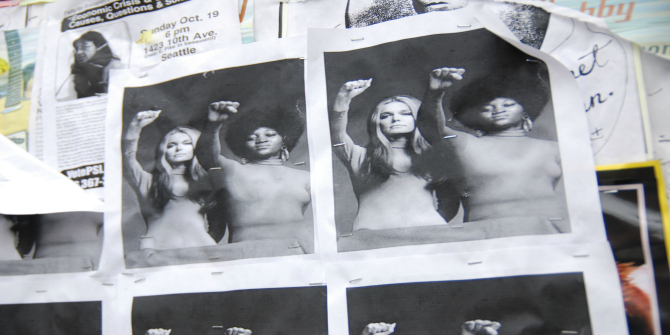When anthropologist Delwar Hussain arrived in a remote coal-mining village on the Bangladesh/India border to research the security fence that India is building around its neighbour, he discovered more about the globalised world than he had expected. This ethnographic study takes in sexuality, aid, and industrialisation, and is valuable for readers looking for a nuanced introduction to the complex and multiple constructions of development along the Bangladesh-India border, writes Chandni Singh.
 Boundaries Undermined: The Ruins of Progress on the Bangladesh-India Border. Delwar Hussain. Hurst. June 2013.
Boundaries Undermined: The Ruins of Progress on the Bangladesh-India Border. Delwar Hussain. Hurst. June 2013.
What do Bangladesh-India geopolitics, an 8 feet tall fence, cross-border coal mining, eunuchs, and neoliberalism have in common? In Boundaries Undermined, The Ruins of Progress on the Bangladesh-India Border, Delwar Hussain straddles these subjects deftly to weave a compelling story of the socio-economic transformations along the Bangladesh-India border, first ushered in by public sector industries, and then by a barely legal coal mining industry. Hussain draws on extensive ethnographic field work conducted as part of his doctoral studies at the University of Cambridge, and details findings from two coal-mining centres: the floodplains of Sylhet (Bangladesh) and the West Khasi Hills of Meghalaya (India). He places this empirical evidence within current debates around development in post-colonial, South-Asian nations and challenges assumptions about the efficacy of neoliberal policies in leading to progress. By doing so, Hussain, an anthropologist by training and Bangladeshi by birth, portrays an intimate and detailed narrative of social, economic and aspirational transformations in borderland communities.
The book has three main strands of investigation. The first uses the case of a limestone mining project in Bangladesh to examine why state-led industrial development – envisaged as a pathway towards ‘progress’ for newly independent countries – failed to deliver equitable development. The second strand follows daily experiences and practices of people – Hindus and Muslims, men, women and eunuchs, young and old – and examines how the neoliberal development model is played out, lived and reimagined in the local context. A third strand analyses the rise of multiple agents of governance actors – the state, civil society, and international donors – and its implications for development in Bangladesh.
In the Introduction and Chapter One (“The Future that did not Happen”), the reader is introduced to the once promising township of Limestone Mining Project at Khonighat (pseudonym) on the Bangladesh floodplains. Beyond the obvious economic development it promised, the state-led project was envisaged as a symbol of modern development making a valuable contribution to the emerging nation of Pakistan. However, slowly it was realised that industrialisation benefited only those inside the ‘enclave of modernity’ while the vast ‘backward’ majority remained steeped in poverty. This disenchantment with inflated public sectors, and distorted economic controls resulted in the closure of the Khonighat Project. In vivid words, Hussain portrays present-day Khonighat as an abandoned township, littered with the debris of a now defunct limestone industry, populated by people tinted with the nostalgia of industrial progress as a route to economic growth and grandiose dreams of their contributions to a ‘progressive’ Bangladesh. Contrastingly, Hussain explores the bustling, unorganised coal mining industry of which village Borapani is a part. Here we meet busy people, faces blackened with coal, lively markets and Muslims and Bengali Hindus continuously negotiating a fine divide between legal and illegal livelihoods. He deconstructs the dichotomy of formal and informal coal mining and elaborates on different working spheres and boundaries for men and women.
It is in Chapter 3 (“The Sexual Lives of Borderlanders”), that Hussain demonstrates his skills as a promising anthropologist by delving into the complexities of the hijra (eunuch) community, central to the coal mining industry in Boripani. Blending extensive ethnographic observation with contemporary debates around the ‘third sex/gender’, Hussain sheds light on the lives, aspirations, and practices of hijras. In doing so, he deconstructs efforts to ‘exoticise and essentialise a social group’ which he concludes ‘for all intents and purposes are like any other social group within society’ (p.81). Husain criticises previous scholarly attempts to categorise the community into neat boxes of hijras and non-hijras because these distinctions lose the ‘fluid, overlapping and contradictory’ nature of individual identities and behaviour that constantly move in and out of the boundaries to which they are confined (p.85). Through engaging storytelling supplemented by quotes, Hussain demonstrates that Borapani hijras see themselves as ‘both man and woman’ and it is this ability to skilfully negotiate the binary gender framework that allows them to be ‘socially active and prominent within the private domains of intimate lives and public world of civic religious and political life’ (p.90).
In Chapter 4 (“State of Relief”), Hussain explores the diminishing role of the state as an agent of growth, and subsequent increasing influence of NGOs. He explains that in Bangladesh there is little difference between State presence in border and non-border regions because earlier as part of Pakistan, and now as independent Bangladesh, the State was never in a position to provide welfare. In its place, NGOs have usurped the role of the state as a vehicle of ‘development’; international NGOs try to use aid effectively, build nationwide infrastructure as well as promote good governance, while the smaller ‘indigenous NGOs’ utilise foreign funds towards welfare of marginalised groups. However, Hussain finds that this NGO phenomenon has not alleviated poverty the way it intended or was expected to. Instead, it has helped propel the middle class towards prosperity while further marginalising the marginalised. To contextualise the role of the State in Bangladesh, he advances the concept of ‘transnational governmentality’ – an extension of Foucault’s governmentatility. The author explains how governing practices are conducted by state actors, by deterritorialised institutions of global governance like the World Bank, WTO, and IMF, and by transnational alliances between NGOs and international donors. He adds that a globalised media and international public opinion are contributors to this multiplicity of governance. The reduction in State accountability has provided the international aid community a license to intrude upon domestic policy. Further, Hussain argues that decentralising the State as the sole actor of governance has implications for international border interactions and has resulted in the heightened securitisation of the Bangladesh-India border signified by the fence building programme.
Boundaries Undermined is valuable for readers looking for a nuanced introduction to the complex and multiple constructions of development along the Bangladesh-India border in particular and south Asia in general. Further, Hussain makes the thesis globally relevant by placing his arguments in the context of enclosure and fencing debates in US-Mexico, Israel-Palestine, and Saudi-Yemen borders. The richness of Hussain’s work, supplemented with his excellent writing promises to provide even experts with fresh insights into constructions of ‘multiple modernities’ and ‘mutating poverties’ in the region. Finally, for anthropology students, the book is instructive in ethnographic research methods. By being upfront about his ambiguous positionality of a Bangladeshi-born, British national and the difficulties in conducting fieldwork in environmentally fragile and politically insecure regions, Hussain gives valuable advice to novice anthropologists. My only critique of Boundaries Undermined, is its somewhat abrupt ending. The brief conclusion, a mere one and a half pages, leaves the reader with lack of closure. However, overall, Boundaries Undermined contributes significantly to debates around the multiple implications of neoliberalisation for post-colonial emerging nations and to the ethnography for South Asia.
———————————————
Chandni Singh is a PhD researcher and Felix Scholar at the University of Reading, where her research explores farmer vulnerability to water scarcity and climate change in Rajasthan, India. She holds an M.Sc. in Natural Resources Management from The Energy and Resources Institute (TERI), New Delhi and a B.Sc. (honours)in Botany from Delhi University. She has worked for two years with indigenous communities in the Himalayas towards watershed development and climate change adaptation. Apart from her research, Chandni is a writer and traveller and has published her poetry and fiction in several magazines. Chandni blogs at Village Vignettes and tweets @chandnisingh233. Read more reviews by Chandni.








Excellent review, captures the essence and nuances of the book accurately.